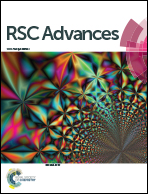Highly stable cycling of a lead oxide/copper nanocomposite as an anode material in lithium ion batteries†
Abstract
Nanostructured composites of lead oxide/copper–carbon (PbO/Cu–C) were synthesized through in situ solvothermal synthesis and heat treatment of PbO/Cu with polyvinyl pyrrolidone (PVP) and used as lithium-ion battery anodes. A PbO active particle was embedded in the Cu and PVP–C matrix, accommodating volume changes and maintaining the electronic conductivity of PbO. The composite exhibits a superior electrochemical performance, with a capacity of 420 mA h g−1 at a current density of 165 mA g−1, compared with previously reported Pb and PbO composite anodes. The developed anode exhibits >90% capacity retention after 9500 cycles, beginning from the second cycle, at a current density of 5.5 A g−1.


 Please wait while we load your content...
Please wait while we load your content...